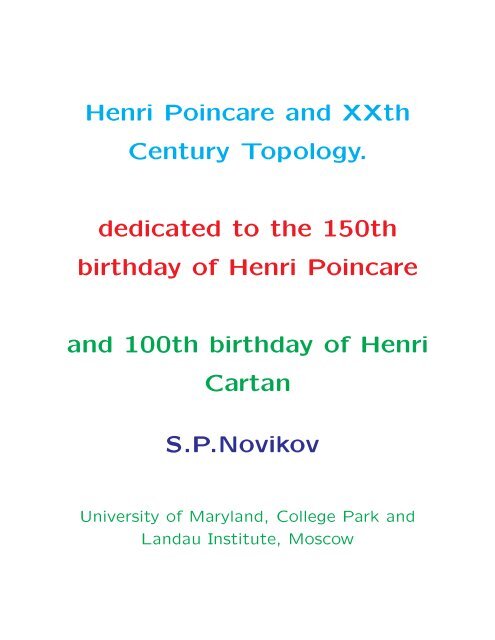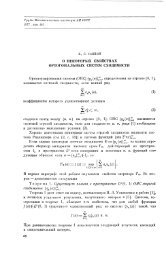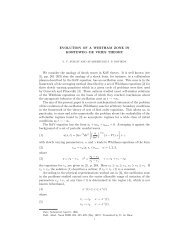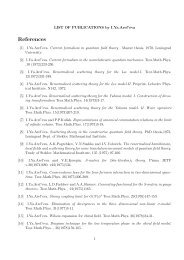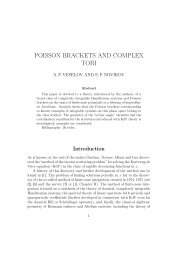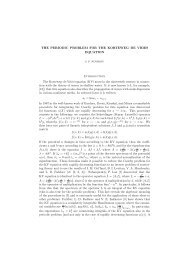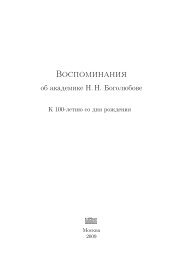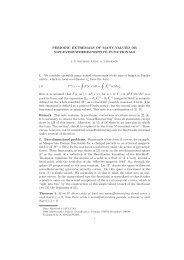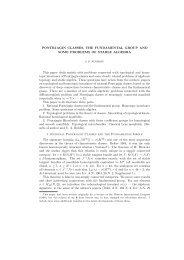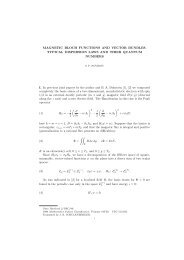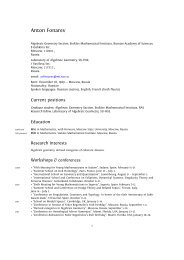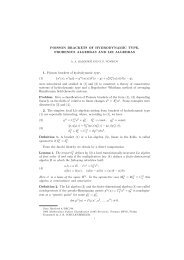Henri Poincare and XXth Century Topology. dedicated to the 150th ...
Henri Poincare and XXth Century Topology. dedicated to the 150th ...
Henri Poincare and XXth Century Topology. dedicated to the 150th ...
You also want an ePaper? Increase the reach of your titles
YUMPU automatically turns print PDFs into web optimized ePapers that Google loves.
<strong>Henri</strong> <strong>Poincare</strong> <strong>and</strong> <strong>XXth</strong><br />
<strong>Century</strong> <strong>Topology</strong>.<br />
<strong>dedicated</strong> <strong>to</strong> <strong>the</strong> <strong>150th</strong><br />
birthday of <strong>Henri</strong> <strong>Poincare</strong><br />
<strong>and</strong> 100th birthday of <strong>Henri</strong><br />
Cartan<br />
S.P.Novikov<br />
University of Maryl<strong>and</strong>, College Park <strong>and</strong><br />
L<strong>and</strong>au Institute, Moscow
110 years passed since <strong>Henri</strong> <strong>Poincare</strong>’ published<br />
his memoir ,,Analysis Situs” (AS, 1895).<br />
<strong>Topology</strong> under <strong>the</strong> name Analysis Situs appeared<br />
as a new branch of Ma<strong>the</strong>matics.<br />
I published my first work in 1959. Since 1970s<br />
I work in different areas of Ma<strong>the</strong>matics <strong>and</strong><br />
Ma<strong>the</strong>matical Physics. However, I consider<br />
myself primarily as a <strong>to</strong>pologist. During my<br />
lifetime I heard a lot of romantic tales about<br />
<strong>the</strong> first works of <strong>Poincare</strong>’ <strong>and</strong> his predecessors<br />
partly based on <strong>the</strong> oral traditions of <strong>to</strong>pologists.<br />
I. What exactly <strong>Poincare</strong>’ did in his works?<br />
This is <strong>the</strong> list: 1.Sur l’ Analysis Situs, C.R.,<br />
1892, 115, 633-636; 2.Sur la generalisation<br />
d’un <strong>the</strong>oreme d’Euler relatif aux polyedres,<br />
C.R., 1893, 117, 144-145; 3.Analysis Situs,–<br />
J.Ecole Polytechniques, 2e ser, 1895 Cahier 1,<br />
1-121; 4.Sur le nombres de Betti.–C.R., 1899,
128, 629-630; 5.Complement a’ ”l’Analysis<br />
Situs”, Rendic. Circ. mat. Palermo, 1899, 13,<br />
285-243; 6.Second complement a’ ”l’Analysis<br />
Situs”,– Proc. London Math. Soc., 1900,<br />
32, 277-308; 7.Sur ”l’Analysis Situs”,– C.R.,<br />
1901, 133, 707-709; 8.Sur la connexion des<br />
surfaces algebriques,– C.R., 1901, 133, 969-<br />
973; 9. Sur certaines surfaces algebriques;<br />
troiseme complement a’ ”l’Analysis Situs”,-1902,<br />
Bull. Soc.Math. France, 30, 49-70; 10.Sur<br />
le cycles des surfaces algebriques; quatrieme<br />
complement a’ ”l’Analysis Situs”,-J. math pures<br />
et appl., 5e ser, 1902,8, 169-214; 11.Cinquieme<br />
complement a ”l’Analysis Situs”,-Rendic.<br />
Circolo mat. Palermo, 1904, 18, 45-110; 12.Sur<br />
un <strong>the</strong>oreme de geometrie,-Rendicotti Circolo<br />
mat. Palermo, 1912, 33, 375-407.<br />
II. How his ideas were reflected in <strong>the</strong> works of<br />
<strong>the</strong> <strong>XXth</strong> <strong>Century</strong> Topologists?
Prehis<strong>to</strong>ry:Ancient Greeks, knots<br />
<strong>and</strong> Alex<strong>and</strong>er The Great: He<br />
<strong>to</strong>ok sword <strong>and</strong> unknotted it in<br />
his own way. Is not it exactly<br />
what our Nature is doing with<br />
DNA in <strong>the</strong> living creatures?<br />
Two observations of Euler. 1.The<br />
Euler identity for <strong>the</strong> numbers of<br />
Vertices (V), Faces (F)<strong>and</strong> Edges<br />
(E) of <strong>the</strong> Convex Poly<strong>to</strong>p in euclidean<br />
3-space: V − E + F = 2
According <strong>to</strong> AS, french ”admiral”<br />
extended this relation <strong>to</strong> <strong>the</strong><br />
nonconvex case.<br />
2.The Imbedding Problem: Three<br />
houses on <strong>the</strong> plane cannot be<br />
joined with three wells by paths<br />
not crossing each o<strong>the</strong>r.<br />
Gauss invented <strong>the</strong> Linking Number<br />
for any pair of closed curves
1 (t), r 2 (s) in <strong>the</strong> 3-space not crossing<br />
each o<strong>the</strong>r. He wrote this<br />
quantity analytically:<br />
{r 1 , r 2 } = ∮ r 1<br />
∮<br />
r 2<br />
(dr 1 × dr 2 , r 1 − r 2 )<br />
|r 1 − r 2 | 3<br />
He found also famous global relation<br />
for <strong>the</strong> curvature K of <strong>the</strong><br />
closed convex surface S:<br />
∫ ∫<br />
S<br />
Kdσ = 4π<br />
The idea of Linking Number had<br />
a background in <strong>the</strong> Electromagnetism.<br />
His pupil, Listing did
something in 1840s <strong>and</strong> invented<br />
<strong>the</strong> word ”<strong>Topology</strong>”.<br />
Maxwell: For <strong>the</strong> isolated isl<strong>and</strong><br />
<strong>the</strong>re is a relation between minima<br />
(Mi), maxima (Ma) <strong>and</strong> saddles<br />
(S) of <strong>the</strong> height function:<br />
Mi + Ma − S = 1<br />
Kelvin found an integral associated<br />
with vorticity:<br />
I = ∫ ∫ ∫ R 3 (v, curl v)d 3 x
Whitehead about 1950 expressed<br />
Hopf Invariant for <strong>the</strong> homo<strong>to</strong>py<br />
groups of spheres in <strong>the</strong> form of<br />
Kelvin Integral. Kelvin intended<br />
<strong>to</strong> classify a<strong>to</strong>ms through <strong>the</strong> <strong>to</strong>pology<br />
of knots (turned out <strong>to</strong> be<br />
a completely wrong idea). His<br />
pupil Tait studied knots in <strong>the</strong><br />
late XIX <strong>Century</strong>. Some of his<br />
observations were proved only in<br />
1980s using Jones Polynomial (see<br />
in <strong>the</strong> book of L.Kaufmann ”Knots<br />
<strong>and</strong> Physics”).
Complex Analysis <strong>and</strong> Theory of<br />
Riemann Surfaces were <strong>the</strong> immediate<br />
predecessors of <strong>Poincare</strong>’.<br />
According <strong>to</strong> <strong>Poincare</strong>’, Betti invented<br />
homology. We see that<br />
Physicists always loved <strong>to</strong>pological<br />
ideas until <strong>the</strong>y are clear <strong>and</strong><br />
nonabstract. Does not it remind<br />
<strong>the</strong> same phenomenon <strong>to</strong>day?
Topological works of <strong>Poincare</strong>’:<br />
Their Contribution <strong>and</strong> immediate<br />
byproduct<br />
<strong>Poincare</strong>’ published 11 works in<br />
<strong>Topology</strong>; <strong>the</strong> central one is AS.<br />
Two Comptes Rendus notes preceding<br />
AS were published in 1892<br />
<strong>and</strong> 1893. Riemann <strong>and</strong> Betti<br />
are named as <strong>the</strong> Ideological Predecessors<br />
in AS: Riemann developed<br />
Analysis Situs for Riemann
Surfaces; Betti invented Cycles<br />
<strong>and</strong> Homology. According <strong>to</strong> my<br />
information, Betti was Chemist.<br />
It explains such terminology as<br />
Homology.<br />
The contents of AS: No motivation<br />
by <strong>the</strong> applications was<br />
given. Following subjects were<br />
discussed in details: 1.Definition<br />
of Manifolds; 2.Cycles <strong>and</strong> Homology;<br />
3. Intersection Index<br />
<strong>and</strong> Duality; 4.Differential Forms
<strong>and</strong> Cycles; 5.Extension of <strong>the</strong><br />
Euler Characteristics for Polyhedra;<br />
6.Fundamental Group; 8.Manifolds<br />
<strong>and</strong> Discrete Groups; 9.Ano<strong>the</strong>r<br />
Approach <strong>to</strong> Manifolds, Poly<strong>to</strong>pes.<br />
His definition of manifolds exactly<br />
describes <strong>the</strong> C 1 –manifolds<br />
with nondegenerate imbedding in<br />
<strong>the</strong> euclidean space. <strong>Poincare</strong>’<br />
unders<strong>to</strong>od <strong>the</strong> idea of orientation<br />
<strong>and</strong> used it. As we know,
<strong>the</strong>se ideas could not be taken as<br />
an initial basis for <strong>the</strong> construction<br />
of <strong>Topology</strong> at that time.Only<br />
after <strong>the</strong> discovery of transversality<br />
<strong>and</strong> o<strong>the</strong>r <strong>to</strong>ols for dealing<br />
with differentiable manifolds by<br />
Whitney in 1930s such program<br />
became realizable.<br />
The definition of cycles <strong>and</strong> homology<br />
classes is taken from Betti.
Cycles are <strong>the</strong> linear combinations<br />
of closed orientable submanifolds<br />
with integral or rational<br />
coefficients. The homological<br />
equivalence of cycles is given<br />
by <strong>the</strong> submanifolds with boundary.<br />
This definition is wrong as<br />
we know: it is based on <strong>the</strong> nonlocal<br />
objects. After <strong>the</strong> proper<br />
corrections it leads <strong>to</strong> <strong>the</strong> ”bordism”<br />
<strong>and</strong> ’cobordism” groups
instead of homology. Atiyah invented<br />
this extraordinary homology<br />
<strong>the</strong>ory in early 1960s. This<br />
nonlocal <strong>the</strong>ory is much more complicated<br />
<strong>and</strong> surprisingly rich (see<br />
in my article S.Novikov, Methods<br />
of Algebraic <strong>Topology</strong> from<br />
<strong>the</strong> viewpoint of <strong>the</strong> Cobordism<br />
Theory, Izvestia, 1967, 31 n 4,<br />
855-951). Let me point out that<br />
it could be constructed only after<br />
<strong>the</strong> Great Revolution in <strong>Topology</strong><br />
(1935-1955). It was R.Thom
who clarified relationship between<br />
cycles <strong>and</strong> submanifolds in early<br />
1950s; his works used all new<br />
technology. No way is known <strong>to</strong><br />
prove this kind of results elementary.<br />
<strong>Poincare</strong> formulated <strong>the</strong> Duality<br />
Law for <strong>the</strong> complementary Betti<br />
numbers of <strong>the</strong> oriented closed<br />
manifolds b i = b n−i . He unders<strong>to</strong>od<br />
it as a byproduct of <strong>the</strong><br />
nondegeneracy property of <strong>the</strong>
intersection index between <strong>the</strong><br />
cycles of complementary dimensions<br />
<strong>and</strong> formulated corollaries<br />
of that for <strong>the</strong> middle-dimensional<br />
homology. Within this approach<br />
one cannot prove <strong>the</strong>se facts. Lefshetz<br />
developed <strong>the</strong>se ideas very<br />
far in 1920s <strong>and</strong> 1930s but proofs<br />
were found only in 1950s in many<br />
cases.<br />
<strong>Poincare</strong> described differential forms<br />
(without formalism of external
product). He formulated what<br />
we call ”DeRham Theorem”. He<br />
never returned <strong>to</strong> differential forms<br />
in <strong>the</strong> latest <strong>to</strong>pological works.<br />
This approach was developed in<br />
1920s: E.Cartan invented convenient<br />
formalism of exterior product<br />
<strong>and</strong> constructed (co)homology<br />
ring. How <strong>to</strong> prove that <strong>the</strong>y are<br />
isomorphic <strong>to</strong> <strong>the</strong> ordinary homology?<br />
It was solved by E.Cartan<br />
himself in <strong>the</strong> special cases <strong>and</strong>
y DeRham in <strong>the</strong> general form<br />
in 1930s.<br />
Universal extension of Euler Characteristics<br />
for all Polyhedra <strong>and</strong><br />
invention of Fundamental Group<br />
were <strong>the</strong> impressive achievements<br />
of AS. There was no way for<br />
him in AS <strong>to</strong> calculate it except<br />
discrete groups. Combina<strong>to</strong>rial<br />
group <strong>the</strong>ory did not existed at<br />
that time. One might say that
this work started it. It was developed<br />
by Dehn in <strong>the</strong> first decade<br />
of <strong>the</strong> <strong>XXth</strong> <strong>Century</strong> who actively<br />
applied it in <strong>the</strong> <strong>the</strong>ory of<br />
knots (I found no traces of knots<br />
in <strong>the</strong> works of <strong>Poincare</strong>).<br />
It was finally clarified in 1950s<br />
<strong>and</strong> 60s by Papakiriakopulos, Haken<br />
<strong>and</strong> Waldhausen that fundamental<br />
group provides a complete set<br />
of invariants for knots, <strong>the</strong> <strong>the</strong>oretical<br />
algorithm was found <strong>to</strong>
test unknotness. In 1930s Nielsen<br />
<strong>and</strong> Magnus made important contribution<br />
<strong>to</strong> <strong>the</strong> combina<strong>to</strong>rial group<br />
<strong>the</strong>ory later developed by people<br />
in Algebra <strong>and</strong> Theory of Algorithms.<br />
<strong>Poincare</strong> already began <strong>to</strong> work<br />
with polyhedra in AS but only<br />
in <strong>the</strong> next works this approach<br />
started <strong>to</strong> dominate. In <strong>the</strong> series<br />
of works after AS <strong>Poincare</strong>
constructed <strong>the</strong> homology <strong>the</strong>ory<br />
based on <strong>the</strong> chains in polyhedra.<br />
It leads <strong>to</strong> <strong>the</strong> exact treatment<br />
of <strong>Poincare</strong> duality, <strong>to</strong> <strong>the</strong><br />
calculations of homology. Fundamental<br />
Group also was effectively<br />
developed through <strong>the</strong> combina<strong>to</strong>rial<br />
approach. Torsion numbers<br />
appeared.<br />
<strong>Poincare</strong> finally established that<br />
full nonabelian fundamental group
is needed for <strong>the</strong> characterization<br />
of <strong>the</strong> 3-sphere (The famous<br />
<strong>Poincare</strong> Conjecture). Let us mention<br />
that for 3-manifolds fundamental<br />
group combined with all<br />
homological quantities cannot characterize<br />
<strong>the</strong>m completely: A new<br />
remarkable invariant was discovered<br />
by Reidemeister in 1930s<br />
leading <strong>to</strong> <strong>the</strong> classification of<br />
lens spaces. It is homo<strong>to</strong>py noninvariant<br />
quantity. Later its extension<br />
by Whitehead led <strong>to</strong> <strong>the</strong>
<strong>the</strong>ory of noncommutative determinant<br />
about 1940.<br />
The development of <strong>Poincare</strong> duality<br />
by Lefshetz <strong>and</strong> Alex<strong>and</strong>er<br />
led <strong>to</strong> <strong>the</strong> duality in <strong>the</strong> group<br />
<strong>the</strong>ory (Pontryagin), <strong>to</strong> <strong>the</strong> idea<br />
of cohomology <strong>and</strong> its ring structure<br />
in 1930s (Kolmogorov <strong>and</strong><br />
Alex<strong>and</strong>er).<br />
Following Conjecture was formulated<br />
in <strong>the</strong> work ”Sur les lignes
geodesiques des surfaces convexes,-<br />
Trans. Amer. Math. Soc.,-<br />
1905, 6, 237-274: The number<br />
of nonselfintersecting closed geodesics<br />
on <strong>the</strong> convex 2-surface is 3 or<br />
more? New variational approach<br />
was found by Birkhof in 1913<br />
<strong>and</strong> developed by Morse in 1920s.<br />
Finally this conjecture was proved<br />
by Liusternik-Schnirelman in 1930s<br />
for all Riemannian manifolds homeomorphic<br />
<strong>to</strong> <strong>the</strong> 2-sphere;The complete<br />
verification of <strong>the</strong> proof was
finished only 60 years later). He<br />
also started <strong>to</strong>pology of symplectic<br />
maps in his last ma<strong>the</strong>matical<br />
work (1912). In <strong>the</strong> philosophical<br />
article published in 1912 <strong>Poincare</strong><br />
wrote that <strong>the</strong> most important<br />
<strong>to</strong>pological problem for him now<br />
is how <strong>to</strong> prove that our space is<br />
3-dimensional. Is this quantity a<br />
<strong>to</strong>pological invariant? <strong>Poincare</strong><br />
considered Continuous Homeomorphism<br />
as a most fundamental<br />
equivalence relation for mani-
folds. For C 1 diffeomorphic manifolds<br />
dimensions are obviously<br />
equal. This problem was solved<br />
by Brauer in 1913 who invented<br />
<strong>the</strong> degree of map. In 1915 Alex<strong>and</strong>er<br />
proved homo<strong>to</strong>py invariance<br />
of homology. His results were<br />
made rigorous in 1940s by Eilenberg<br />
<strong>and</strong> o<strong>the</strong>rs who formalized<br />
singular homology <strong>the</strong>ory. Cell<br />
complexes appeared in 1940s making<br />
rigorous <strong>the</strong> Morse Theory
with <strong>the</strong> help of transversality technic.<br />
<strong>Topology</strong> after <strong>Poincare</strong>’<br />
I see <strong>the</strong> <strong>XXth</strong> <strong>Century</strong> <strong>Topology</strong><br />
as a series of <strong>the</strong> following<br />
periods:<br />
I.The Post-<strong>Poincare</strong> Period (1912-<br />
1940) Several outst<strong>and</strong>ing people<br />
developed <strong>the</strong> ideas discussed
y <strong>Poincare</strong>’. Their names appeared<br />
in <strong>the</strong> previous part. Let<br />
me add <strong>the</strong> name of H.Hopf who<br />
really discovered in 1930s <strong>the</strong> new<br />
deep homo<strong>to</strong>py <strong>to</strong>pology associated<br />
with <strong>the</strong> homo<strong>to</strong>py groups<br />
of spheres. Hopf started many<br />
fundamental directions between<br />
1920th <strong>and</strong> 1950th.<br />
II. The Great Revolution in <strong>Topology</strong><br />
(1935-1955) The Theory of<br />
Smooth Manifolds including <strong>the</strong>
idea of Transversality <strong>and</strong> Analysis<br />
on Manifolds was created;<br />
The Fibre Bundles, Connections<br />
<strong>and</strong> Characteristic Classes were<br />
discovered, various Homo<strong>to</strong>py Obstruction<br />
Theories were constructed.T<br />
Categorial Homology Theories of<br />
Spaces, Sheafs <strong>and</strong> Fibre Bundles<br />
were developed leading <strong>to</strong><br />
<strong>the</strong> great Homological Methods<br />
like Exact <strong>and</strong> Spectral Sequences,<br />
Cohomological Operations <strong>and</strong> o<strong>the</strong>r
<strong>to</strong>ols; Huge machinery for calculation<br />
of <strong>the</strong> Homo<strong>to</strong>py Groups<br />
of Spheres was constructed; <strong>the</strong><br />
Cobordisms were essentially calculated;<br />
The Homological Algebra<br />
<strong>and</strong> Hopf Algebras were invented.<br />
Let me give list of <strong>the</strong><br />
most important names: Whitney,<br />
Hopf, Pontryagin, Chern, Hodge,<br />
Steenrod, Whitehead, Eilenberg-<br />
McLane, Leray, Serre, H.Cartan,
Thom, Borel. Milnor <strong>and</strong> Gro<strong>the</strong>ndick<br />
began at <strong>the</strong> end of that period<br />
inventing new great ideas.<br />
They started <strong>the</strong> next period when<br />
I worked.The names of main <strong>to</strong>pological<br />
players are dropped here<br />
(see my new article S.Novikov,<br />
<strong>Topology</strong> of XX <strong>Century</strong>: The<br />
view from inside, Russian Math<br />
Surveys, 2004, vol 59,n 6).)<br />
III.Byproduct of <strong>the</strong> Great Revolution<br />
(1955-1970); <strong>Topology</strong> as
a Centrum of Interaction. During<br />
that period many fundamental<br />
problems of <strong>Topology</strong> were<br />
solved; Several applications of <strong>to</strong>pological<br />
ideas in o<strong>the</strong>r areas of ma<strong>the</strong>matics<br />
were found. (The subjects<br />
where I was involved myself<br />
are colored in Blue here. The<br />
problems whose solution really required<br />
<strong>the</strong> use of <strong>the</strong> new algebraic<br />
methods are marked at<br />
<strong>the</strong> beginning by <strong>the</strong> sign (!);<br />
The results obtained in <strong>the</strong> late
1960s <strong>and</strong> 1970s whose full proof<br />
is not written yet in <strong>the</strong> literature,<br />
are marked at <strong>the</strong> beginning<br />
by <strong>the</strong> sign (?).).<br />
Manifolds, n ≠ 4: (!)Nonst<strong>and</strong>ard<br />
Differentiable Structures on<br />
<strong>the</strong> 7-Sphere were discovered <strong>and</strong><br />
classified for n > 4; Nonsmoothable<br />
manifolds were found; The<br />
<strong>to</strong>rsion of Pontryagin Classes was<br />
found <strong>to</strong> be noninvariant; <strong>Poincare</strong>
Conjecture <strong>and</strong> h-cobordism <strong>the</strong>orem<br />
were proved; (!)The classification<br />
of immersions <strong>and</strong> imbeddings<br />
of manifolds were obtained;<br />
(!)Classification Theory of multidimensional<br />
smooth manifolds<br />
was constructed; (!)Relationship<br />
between smooth <strong>and</strong> PL manifolds<br />
was unders<strong>to</strong>od; (!)Topological<br />
Invariance of <strong>the</strong> Periods<br />
of Pontryagin Classes along <strong>the</strong><br />
cycles was proved;(!)The so-called<br />
Annulus Conjecture was proved;
(!)(?)Hauptvermutung was proved<br />
for manifolds without 2-<strong>to</strong>rsion<br />
in <strong>the</strong> 3-homology; (!)Counterexamples<br />
<strong>to</strong> Hauptvermutung were<br />
found for <strong>the</strong> nonmanifolds first<br />
<strong>and</strong> later for manifolds; (!,?)Some<br />
sort of classification of Topological<br />
Manifolds was obtained.Several<br />
fundamental problems of <strong>the</strong> 3D<br />
<strong>Topology</strong> <strong>and</strong> knot <strong>the</strong>ory were<br />
also solved in 1960s. Let us mention<br />
that in 1980s <strong>the</strong>se people<br />
realized <strong>the</strong> great computational
program leading <strong>to</strong> <strong>the</strong> proof of<br />
<strong>the</strong> famous 4-color problem. The<br />
existence <strong>and</strong> uniqueness of differentiable<br />
structure on 3-manifold<br />
was established in early 1950s<br />
by <strong>the</strong> elementary methods.New<br />
achievements of <strong>the</strong> 3D <strong>Topology</strong><br />
made possible <strong>the</strong> development<br />
of <strong>the</strong> Hyperbolic <strong>Topology</strong><br />
of 3-manifolds in 1970s. The<br />
technic of differential <strong>to</strong>pology<br />
was extended in 1970s <strong>to</strong> <strong>the</strong>
4-manifolds. It led <strong>to</strong> <strong>the</strong> construction<br />
of <strong>the</strong> purely continuous<br />
homeomorphisms only: it<br />
was proved that homo<strong>to</strong>py equivalent<br />
simply connected 4-manifolds<br />
are homeomorphic.The discovery<br />
of nonst<strong>and</strong>ard differential structures<br />
here belongs <strong>to</strong> <strong>the</strong> new<br />
era in <strong>Topology</strong>: it is a byproduct<br />
of <strong>the</strong> activity of physicists<br />
<strong>and</strong> achievements of <strong>the</strong> qualitative<br />
<strong>the</strong>ory of <strong>the</strong> nonlinear PDEs.
Calculations: The stable homo<strong>to</strong>py<br />
groups of <strong>the</strong> classical Lie<br />
Groups were found through <strong>the</strong><br />
calculus of variations; (!) Hopf<br />
Invariant Problem was solved, <strong>the</strong><br />
nonexistence of <strong>the</strong> Divisible Algebras<br />
in higher dimensions was<br />
proved; (!)The Extraordinary Homology<br />
Theories were invented:<br />
<strong>the</strong> K-Theory brought new dimensions<br />
<strong>to</strong> <strong>the</strong> homological methods;<br />
(!)The Cobordism Theory
was developed; it improved methods<br />
of studying stable homo<strong>to</strong>py<br />
groups of spheres <strong>and</strong> fixpoints<br />
of <strong>the</strong> compact groups acting on<br />
manifolds ; The Categorial ”Localization<br />
Idea” was invented helping<br />
<strong>to</strong> solve some deep problems<br />
of <strong>the</strong> Homo<strong>to</strong>py <strong>Topology</strong>; Nontrivial<br />
finite-dimensional H-spaces<br />
were discovered.<br />
Interaction with o<strong>the</strong>r areas of<br />
Ma<strong>the</strong>matics: (!) Riemann-Roch
Theorem in Algebraic Geometry<br />
was proved as an application of<br />
<strong>the</strong> Cobordism Theory. Completely<br />
new approach was discovered<br />
leading <strong>to</strong> <strong>the</strong> so-called K-<br />
Theory; (!) The index problem<br />
for <strong>the</strong> Elliptic PD Opera<strong>to</strong>rs was<br />
solved on <strong>the</strong> basis of Cobordisms<br />
<strong>and</strong> K-Theory; The revolutionary<br />
new underst<strong>and</strong>ing of <strong>the</strong> <strong>Topology</strong><br />
of Multidimensional Dynamical<br />
Systems was invented by <strong>to</strong>pologists;<br />
Main problems were solved
for <strong>the</strong> codimension one foliations<br />
including <strong>the</strong> proof of existence<br />
of compact leaves on <strong>the</strong><br />
3-sphere; New areas of Algebra<br />
were created such as <strong>the</strong> Algebraic<br />
K-Theory, Theory of Hopf<br />
Algebras, The Homological Algebra.<br />
IV.Dispersion of Multidimensional<br />
<strong>Topology</strong>, The Hyperbolic <strong>Topology</strong>;<br />
Discovery of Topological Phenomena<br />
in Physics (1970s)
V.Revival of <strong>Topology</strong>; Physicists<br />
in <strong>Topology</strong> (1980-2000)<br />
Let me recommend my minibook<br />
published in Encyclopedia of Math<br />
Sciences: S.Novikov, <strong>Topology</strong><br />
I, EMS, vol 12, Springer, 1997.<br />
VI.New ideas: Is it possible <strong>to</strong><br />
solve difficult problems in <strong>the</strong> <strong>the</strong>ory<br />
of 3-manifolds analytically?


